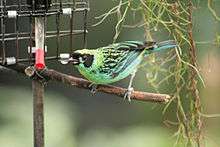Tangara (genus)
| Tangara | |
|---|---|
 | |
| Paradise tanager, Tangara chilensis | |
| Scientific classification | |
| Kingdom: | Animalia |
| Phylum: | Chordata |
| Class: | Aves |
| Order: | Passeriformes |
| Family: | Thraupidae |
| Genus: | Tangara Brisson, 1760 |
| species | |
|
About 50, see list | |


.jpg)
Tangara is a large genus of birds of the tanager family. It includes about 50 species, but as currently defined the genus is polyphyletic.[1] All are from the Neotropics, and while most are fairly widespread, some have small distributions and are threatened. They are fairly small, ranging in size from 11.5–15 centimetres (4.5–5.9 in). This genus includes some of the most spectacularly colored birds of the world.
These tanagers are mainly found high in forest canopies, but some occupy more open habitat. They are found at all elevations below tree line but are most diverse in the Andean subtropical and foothill forests of Colombia, Ecuador and Peru.
The female builds a usually well concealed cup nest and lays two brown- or lilac-speckled white eggs. These hatch in 13–14 days and the chicks fledge in a further 15–16 days. The male and female feed the nestlings on insects and fruit, and may be assisted by helpers.
Tangara tanagers pick insects from leaves, or sometimes in flight, but fruit is a major dietary item, accounting for 53-86% of food items in those species which have been studied.
Species in taxonomic order
- Plain-coloured tanager, Tangara inornata
- Turquoise tanager, Tangara mexicana
- White-bellied tanager, Tangara mexicana brasiliensis
- Cabanis's tanager, Tangara cabanisi
- Gray-and-gold tanager, Tangara palmeri
- Paradise tanager, Tangara chilensis
- Seven-coloured tanager, Tangara fastuosa
- Green-headed tanager, Tangara seledon
- Red-necked tanager, Tangara cyanocephala
- Brassy-breasted tanager, Tangara desmaresti
- Gilt-edged tanager, Tangara cyanoventris
- Blue-whiskered tanager, Tangara johannae
- Green-and-gold tanager, Tangara schrankii
- Emerald tanager, Tangara florida
- Golden tanager, Tangara arthus
- Silver-throated tanager, Tangara icterocephala
- Golden-eared tanager, Tangara chrysotis
- Saffron-crowned tanager, Tangara xanthocephala
- Flame-faced tanager, Tangara parzudakii
- Yellow-bellied tanager, Tangara xanthogastra
- Spotted tanager, Tangara punctata
- Speckled tanager, Tangara guttata
- Dotted tanager, Tangara varia
- Rufous-throated tanager, Tangara rufigula
- Bay-headed tanager, Tangara gyrola
- Rufous-winged tanager, Tangara lavinia
- Burnished-buff tanager, Tangara cayana
- Black-backed tanager, Tangara peruviana
- Lesser Antillean tanager, Tangara cucullata
- Chestnut-backed tanager, Tangara preciosa
- Scrub tanager, Tangara vitriolina
- Green-capped tanager, Tangara meyerdeschauenseei
- Rufous-cheeked tanager, Tangara rufigenis
- Golden-naped tanager, Tangara ruficervix
- Metallic-green tanager, Tangara labradorides
- Blue-browed tanager, Tangara cyanotis
- Blue-necked tanager, Tangara cyanicollis
- Golden-hooded tanager, Tangara larvata
- Masked tanager, Tangara nigrocincta
- Spangle-cheeked tanager, Tangara dowii
- Green-naped tanager, Tangara fucosa
- Beryl-spangled tanager, Tangara nigroviridis
- Blue-and-black tanager, Tangara vassorii
- Black-capped tanager, Tangara heinei
- Sira tanager, Tangara phillipsi
- Silver-backed tanager, Tangara viridicollis
- Straw-backed tanager, Tangara argyrofenges
- Black-headed tanager, Tangara cyanoptera
- Opal-rumped tanager, Tangara velia
- Silvery-breasted tanager, Tangara velia cyanomelas
- Opal-crowned tanager, Tangara callophrys
References
- ↑ Sedano, R. E., & BURNS, K. J. (2010). Are the Northern Andes a species pump for Neotropical birds? Phylogenetics and biogeography of a clade of Neotropical tanagers (Aves: Thraupini). Journal of Biogeography 37: 325–343.
- ffrench, Richard (1991). A Guide to the Birds of Trinidad and Tobago (2nd ed.). Comstock Publishing. ISBN 0-8014-9792-2..
- Hilty, Steven L (2003). Birds of Venezuela. London: Christopher Helm. ISBN 0-7136-6418-5..
- Morton, Isler & Isler, Tanagers ISBN 0-7136-5116-4.
- Stiles and Skutch, A guide to the birds of Costa Rica ISBN 0-8014-9600-4.
| Wikimedia Commons has media related to |